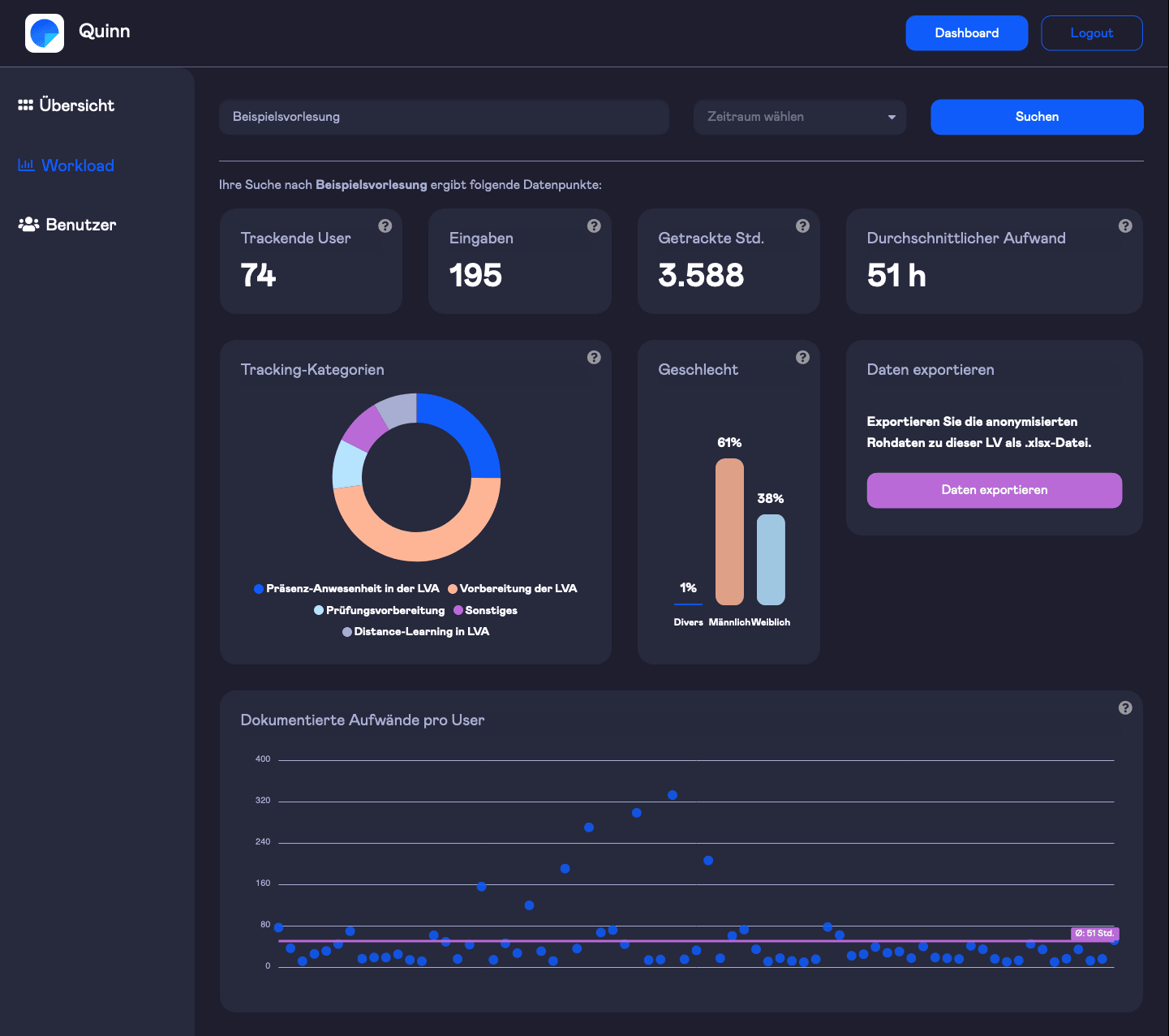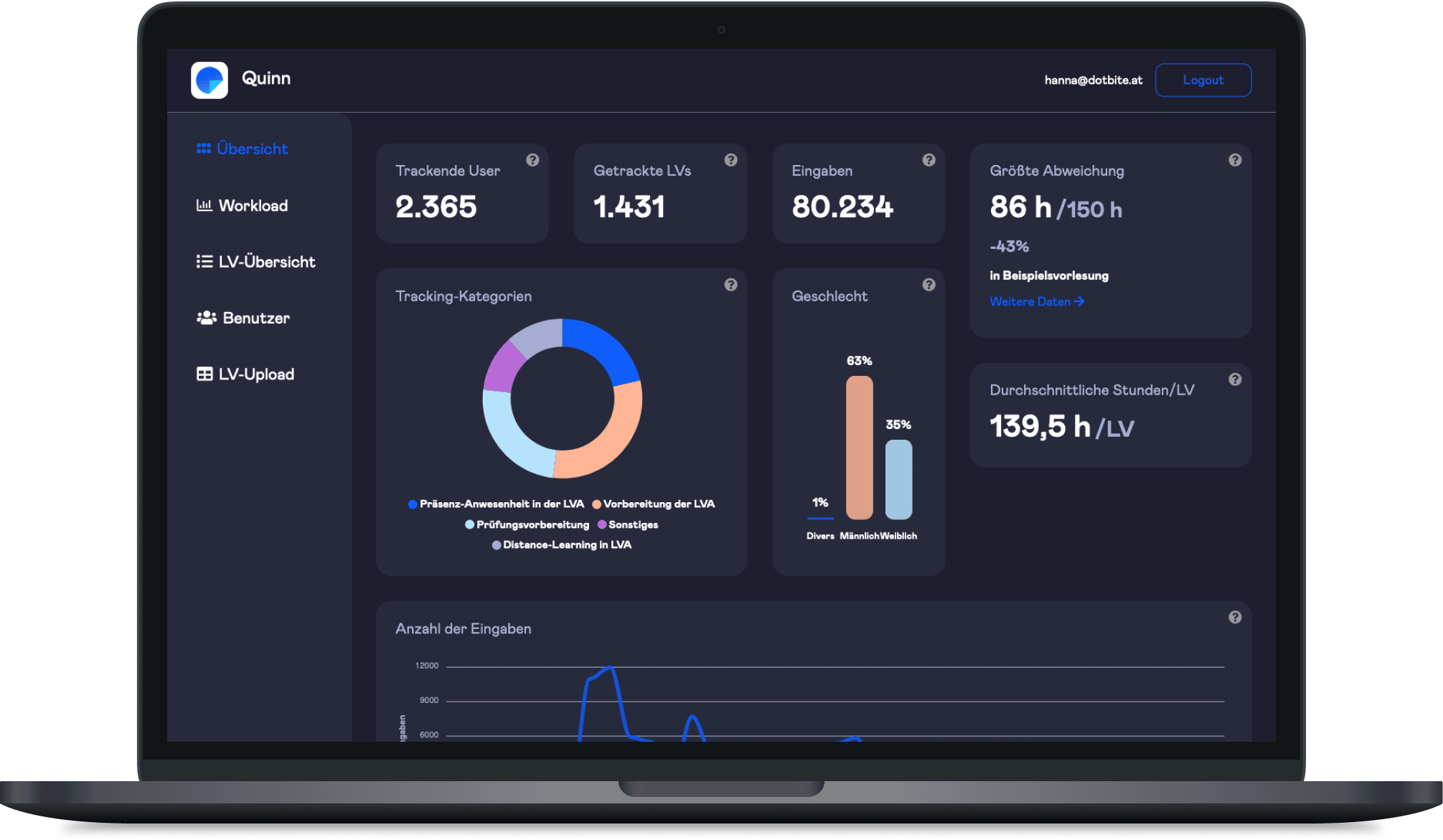

Quinn
Our native ECTS evaluation app: A win-win for universities and students
Outline
Challenges
The European Credit Transfer and Accumulation System (ECTS) is a standard means for comparing academic credits, i.e., the "volume of learning based on the defined learning outcomes and their associated workload" for higher education across the European Union and other collaborating European countries. One ECTS credit point corresponds to 25 hours of work.
Flow
For students
Learning diary
The focus of the app is to always emphasize the added value for students, to make entering effort fast and straightforward, and to communicate the reasons and goals of the survey as transparent and trustworthy as possible. Quinn is for its users a whole different app than for the university: A learning diary that is completely adapted to promised to design such a positive user experience that material recompense would not be necessary as a motivation for evaluation. The app's success so far proves that for students the opportunity to monitor individual learning successes and support the further development of their own university weighs much more than financial or material reward systems for evaluating ECTS. We held our promise.
Semester planning
Users can quickly and easily determine which days they would like to invest time in their various courses. As a result, the app automatically creates a semester schedule. The semester plan clearly displays the entire semester at a glance, and new courses can be added at any time. Students are also reminded daily of upcoming lectures via local notifications.
Learning analytics
The statistics of the students' own performance and efforts, which can be viewed at any time, enable them to self-monitor and analyze their studies to reflect on and optimize their own learning behavior. Furthermore, the data can be evaluated weekly and monthly and divided into categories.
For universities
The most essential aspect for universities is, of course, to obtain very accurate and reliable data on the courses they offer. Since the incoming data are collected over the semester and during the courses, they are actual hours and not improvised numbers that students try to recall from memory at the end of the semester. This is because users do not only use the app to evaluate ECTS but also utilize Quinn as a learning diary that has a real benefit for them in their everyday student life. The accumulated workloads are aggregated and analyzed to obtain a valid statement about the average time required per course. Here, coronavirus pandemic made life incredibly difficult for students, which is why the demands on Quinn also grew. Especially distance learning as the new form of studying and thus one of the options to implement in the app was of great importance for the universities and students plagued by dashboard, which allows a semester-long evaluation of all incoming data. It clearly presents tracked data from the Quinn app, so universities can see at a glance where action may be needed. Data tracked by students on their learning effort is collected anonymously in the dashboard and turned into understandable graphs. Appropriate graphs such as line graphs, bar graphs, or scatter plots were chosen for a clear presentation of the data. An overview page displays the entire data for each university, which can be filtered by course and period so that courses can also be evaluated individually. An admin of the university can authorize persons for specific courses or curricula and manage these rights.

Tech stack
Vue.js
Laravel
Flutter
Apex
Bootstrap

MySQL
Connecting the dots
Quinn is a win-win situation for students and universities. Thanks to its excellent UI, the app is very intuitive to use, and workloads can be entered within seconds. The statistics and self-tracking options are embraced by students, particularly because they know it makes their studies fairer. On the other hand, universities receive accurate and verifiable figures on course workloads and can compare them with the respective ECTS at a glance. The data is collected centrally and anonymized throughout the year and clearly visualized in the dashboard. Consequently, any necessary adjustment in terms of ECTS fairness is easy.
Achievements
4.000+
Users
14.000+
Tracked courses
300.000+
Tracked hours

Quinn provides the foundation: time expenditures are aggregated and analyzed to provide a valid statement of the average time required. The results provide the basis for strategic decisions by university management to identify necessary changes to the curricula.
Ao.Univ.Prof. Dipl.-Ing. Dr.techn. Kurt Mayas – Vizerektor Studium & Lehre TU Wien






